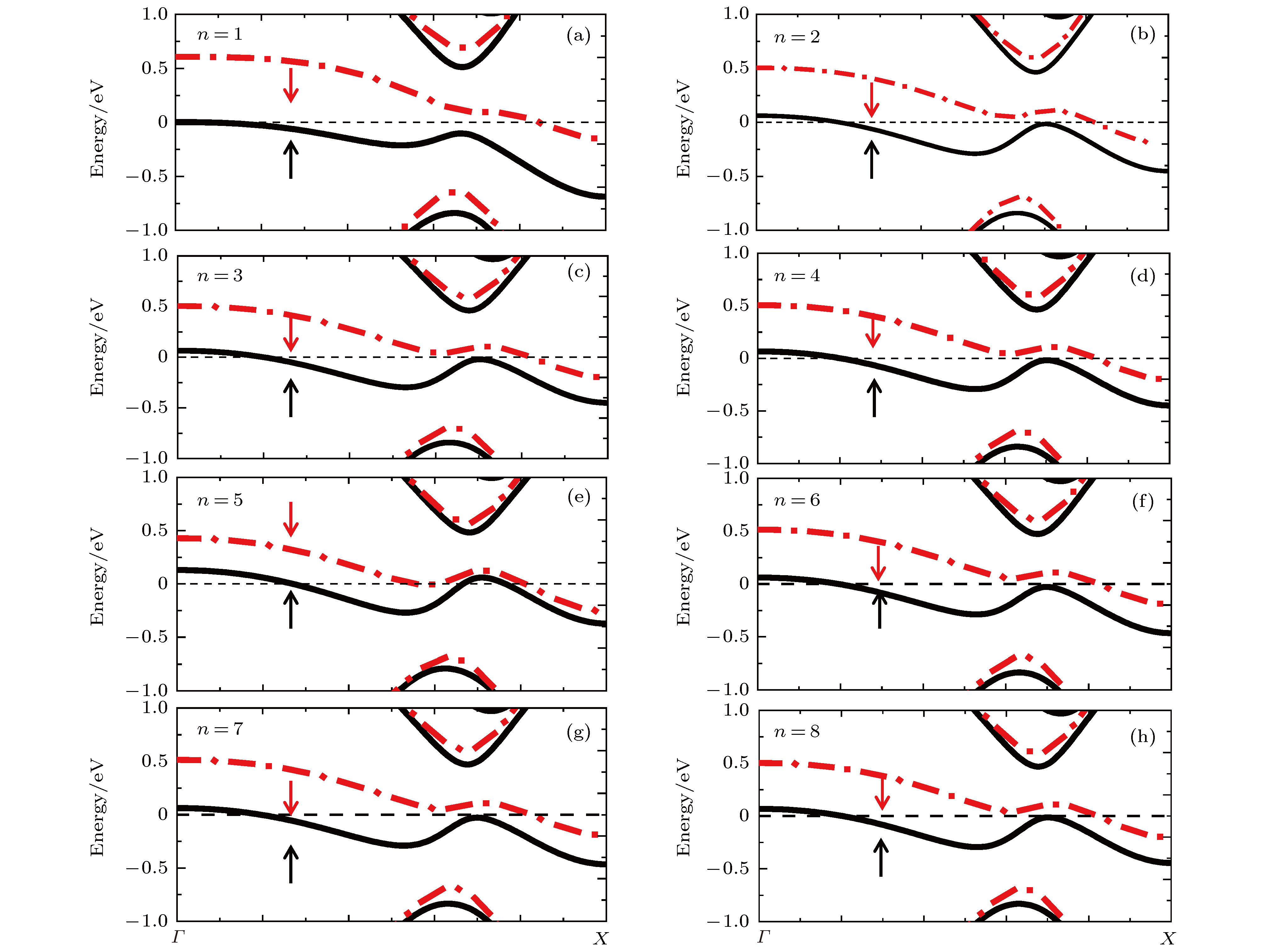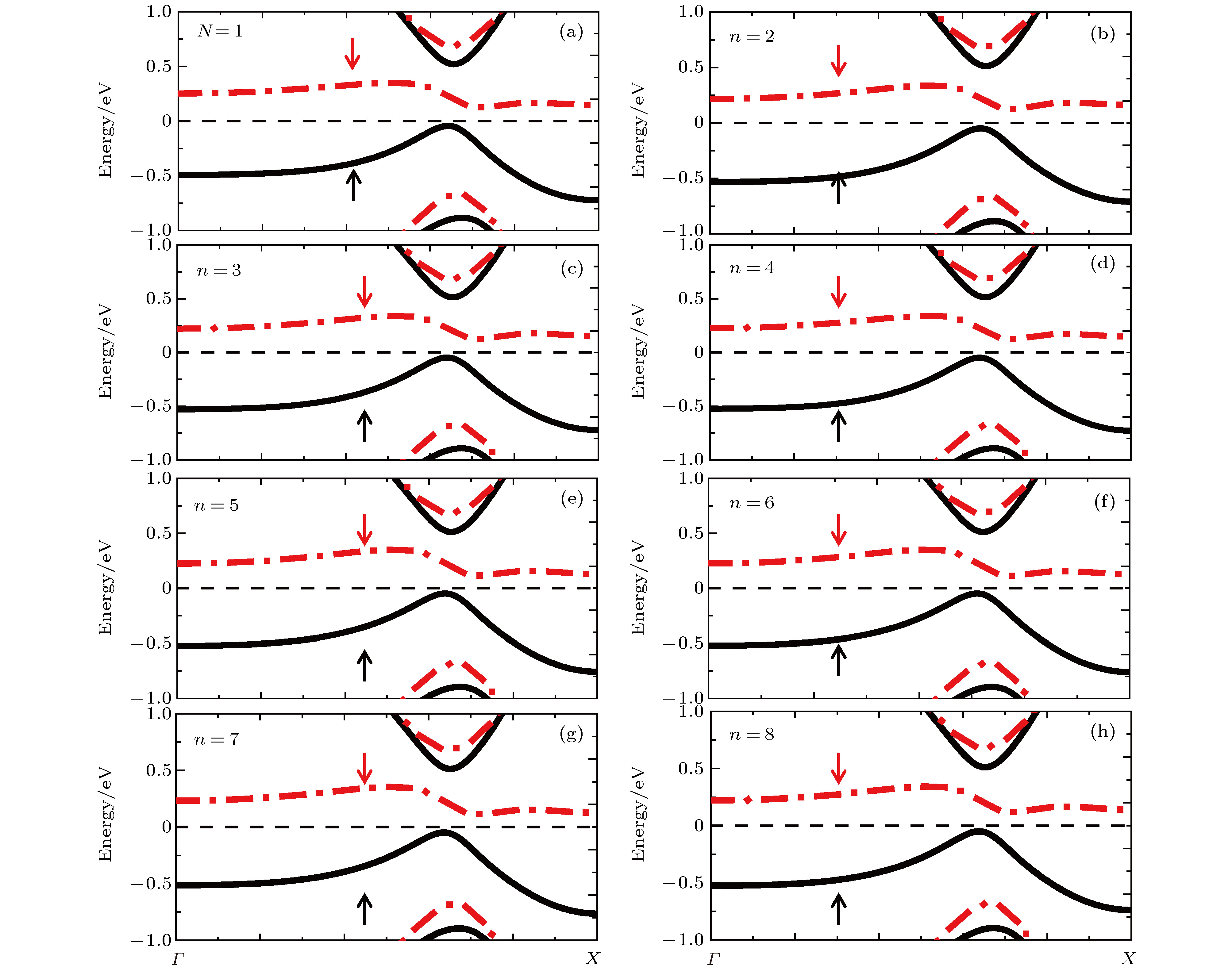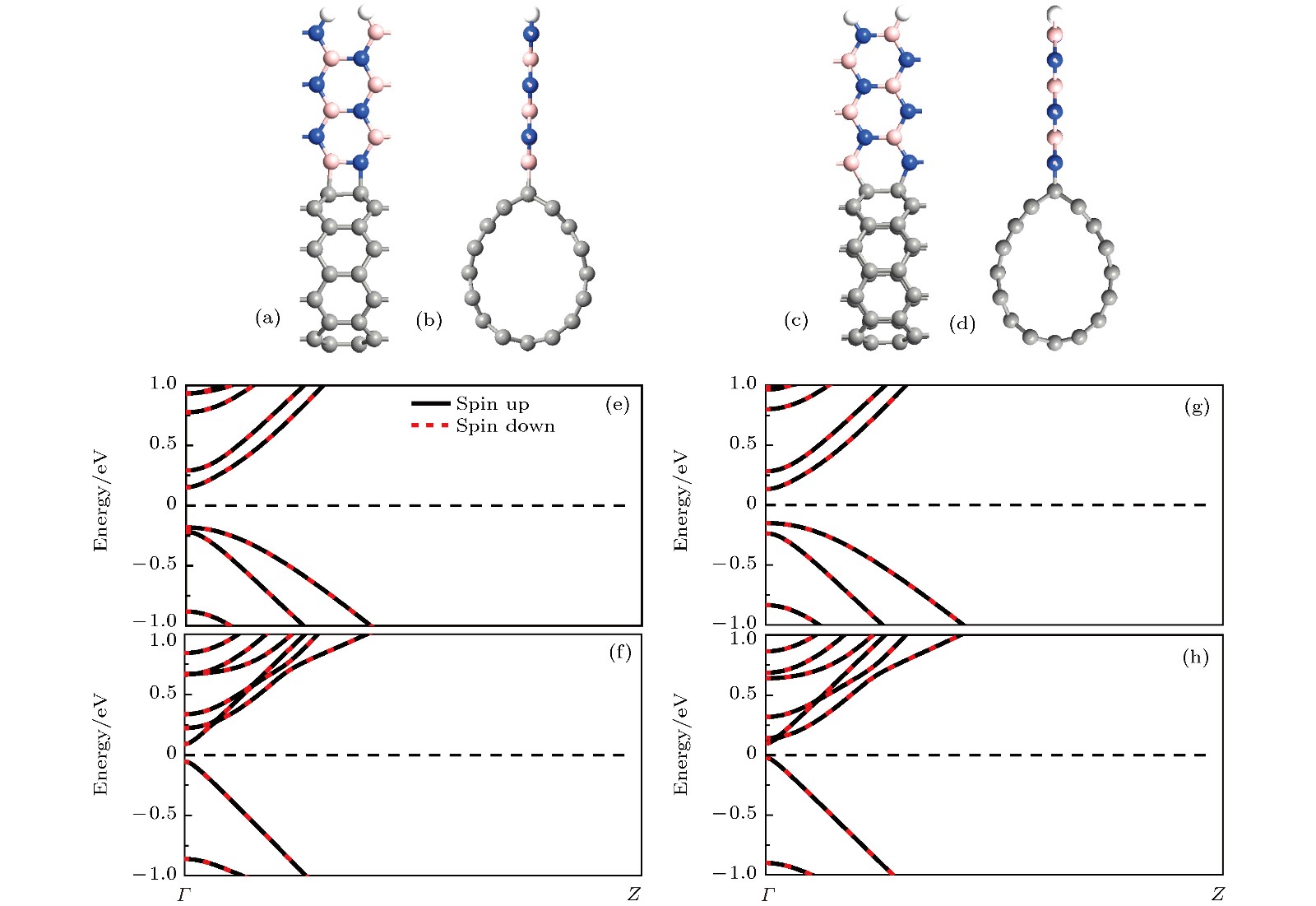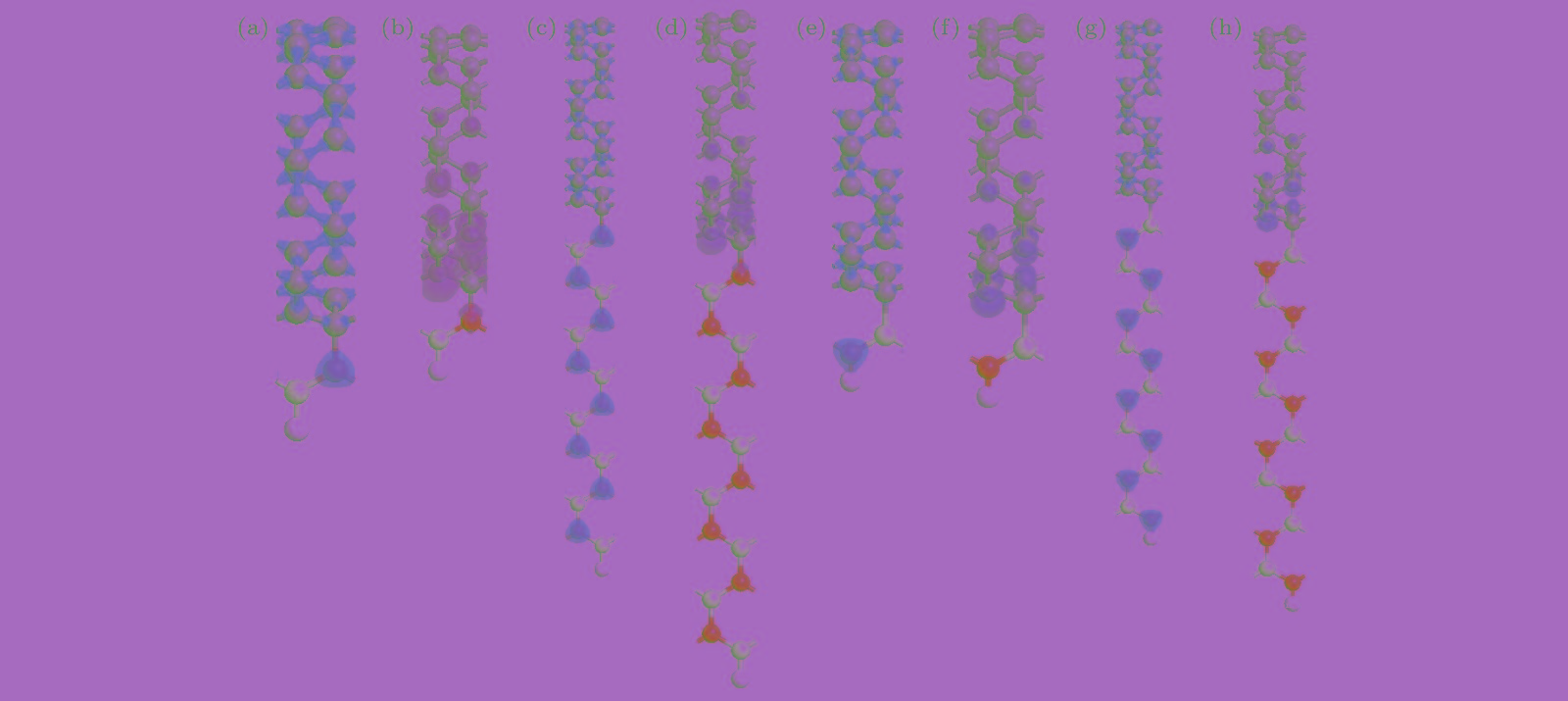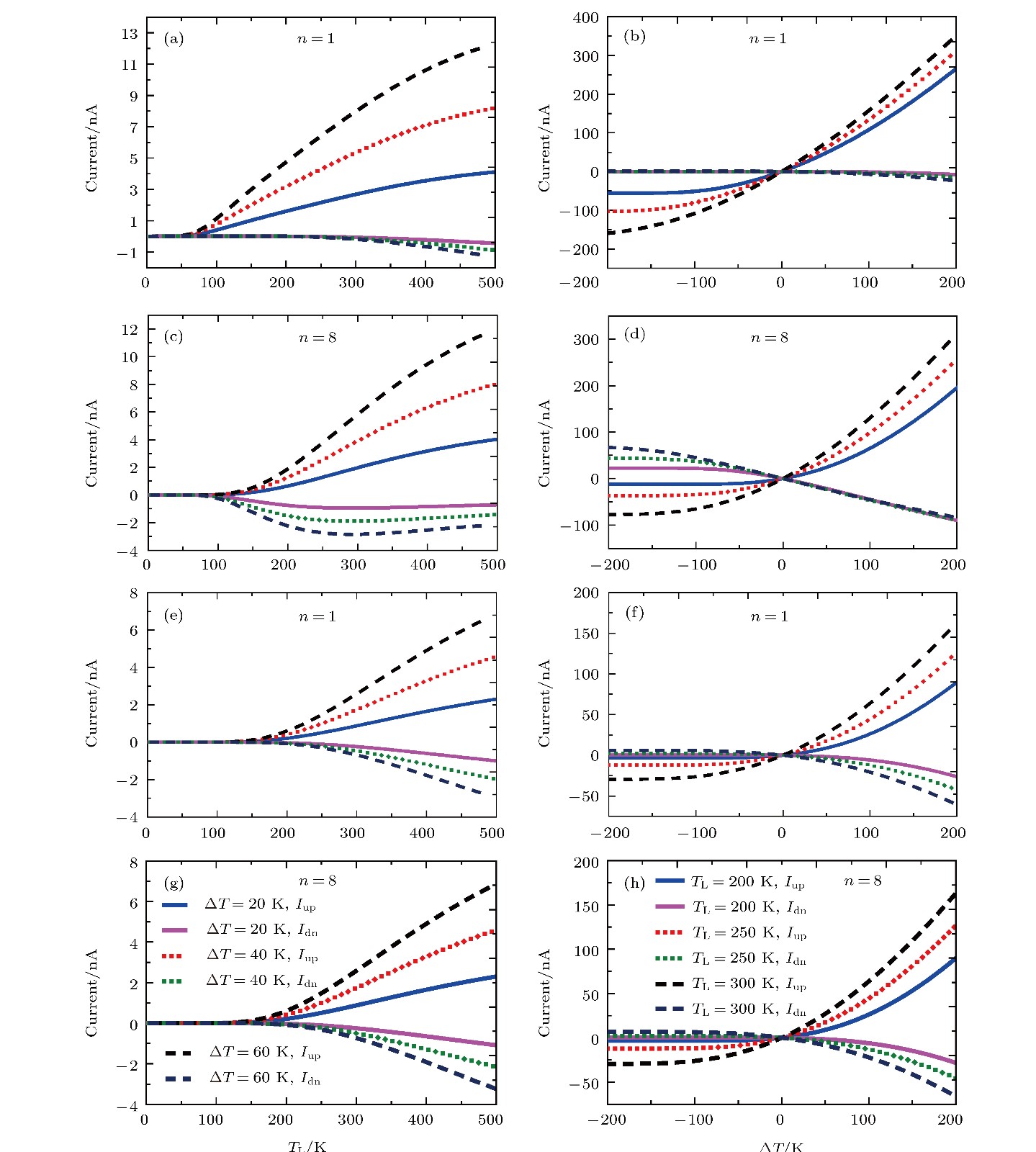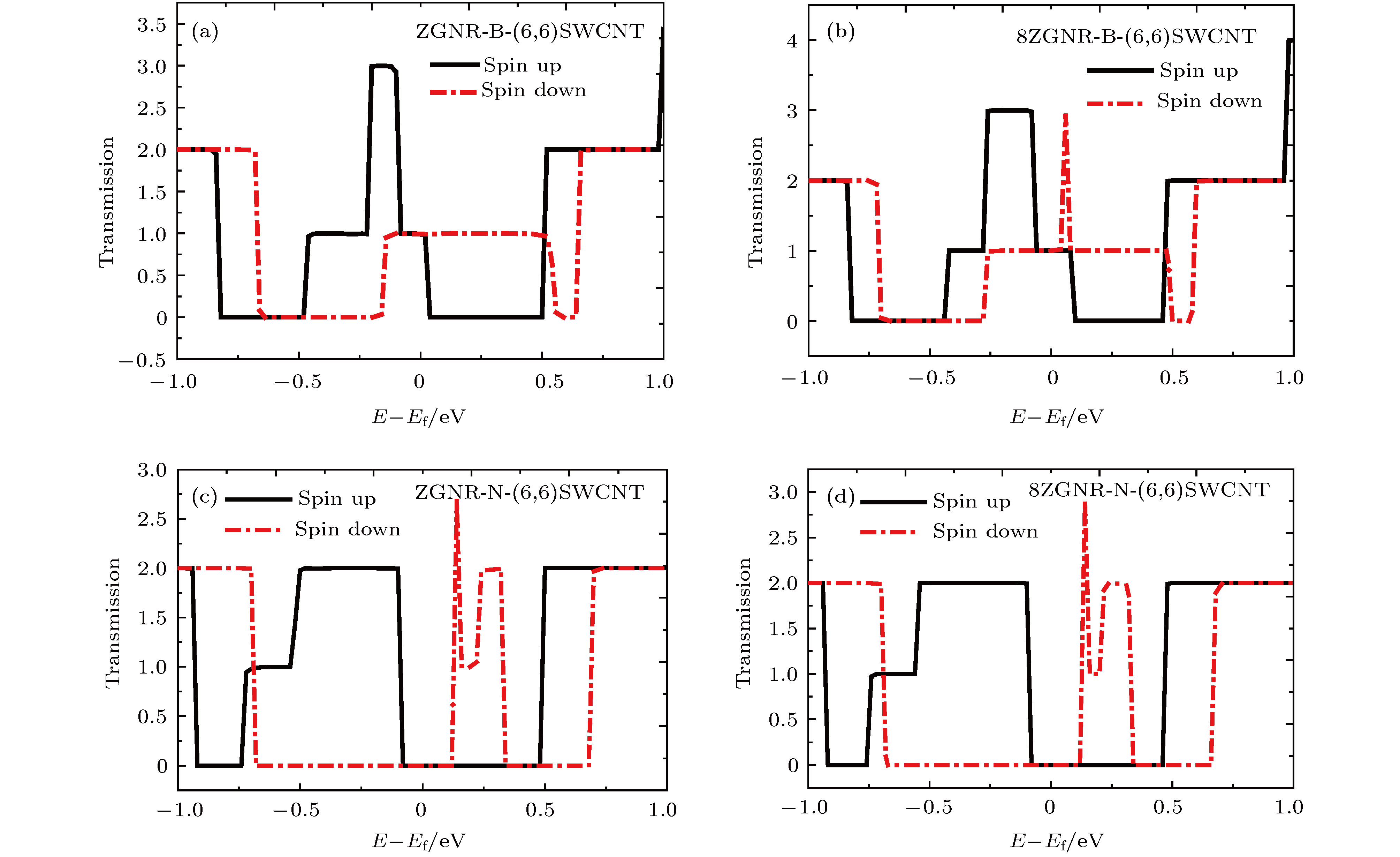-
热自旋电子学器件结合了自旋电子学和热电子学各自的优点, 对人类可持续发展具有重要作用. 本文研究了锯齿形BN纳米带(ZBNRs)共价功能化碳纳米管(SWCNT)的电子结构, 发现ZBNRs-B-(6, 6)SWCNT为磁性半金属, nZBNRs-B-(6, 6)SWCNT (n = 2—8)为磁性金属; nZBNRs-N-(6, 6)SWCNT (n = 1—8)为双极化铁磁半导体; 4ZBNRs-B-(4, 4)SWCNT和4ZBNRs-N-(4, 4)SWCNT为磁性半金属, 4ZBNRs-B-(m, m)SWCNT (m = 5—9)为磁性金属; 4ZBNRs-N-(m, m)SWCNT (m = 5—9)为双极化铁磁半导体. 然后, 基于锯齿形BN纳米带共价功能化碳纳米管设计了新型热自旋电子学器件, 发现基于ZBNRs-N-(6, 6)SWCNT的器件具有热自旋过滤效应; 而8ZBNRs-N-(6, 6)SWCNT和nZBNRs-B-(6, 6)SWCNT (n = 1, 8)都存在自旋相关塞贝克效应. 这些发现表明BN纳米带功能化碳纳米管在热自旋电子学器件方面具有潜在的应用.The spin caloritronics device, because of the characteristics of spintronics and thermoelectronics, plays an important role in human sustainable development. A lot of spin caloritronic devices based carbon materials (such as graphene nanoribbons, carbon nanotubes) have been reported. However, there are few studies of the thermal spin transport properties in a hybrid structure of single-walled carbon nanotubes and zigzag-edge BN nanoribbons, and the thermal spin transport mechanism of this structure is still unclear. In this paper, using the nonequilibrium Green’s function (NEGF) combined with the first principle calculations, the electronic structures and the thermal spin transport properties of the zigzag edge BN nanoribbons functionalized single-walled carbon nanotubes are studied. It is shown that the ZBNRs-N-(6, 6)SWCNT is a half-metal, while the nZBNRs-N-(6, 6)SWCNT are magnetic metals (n = 2−8), and the nZBNRs-B-(6, 6)SWCNT are bipolar magnetic semiconductors (n = 1−8). The 4ZBNRs-N-(4, 4)SWCNT and 4ZBNRs-B-(4, 4)SWCNT are half-metals, while the 4ZBNRs-B-(m, m)SWCNT (m = 5−9)are magnetic metals, and the 4ZBNRs-N-(m, m)SWCNT (m = 5−9) are bipolar magnetic semiconductors. Then, some novel spin caloritronicdevices are designed based on nZBNRs-N-(6, 6)SWCNT and nZBNRs-B-(6, 6)SWCNT (n = 1, 8). For the ZBNRs-B-(6, 6)SWCNT, when the temperature of the left electrode is increased above a critical value, the thermal spin-up current then increases remarkably from zero. Meanwhile the thermal spin-down current remains approximately equal to zero in the entire temperature region, thus indicating the formation of a thermal spin filter. For the 8ZBNRs-N-(6, 6)SWCNT and nZBNRs-B-(6, 6)SWCNT (n = 1, 8), when a temperature gradient is produced between two electrodes, the spin-up and spin-down currents are driven in the opposite directions, which indicates that the spin-dependent Seebeck effect (SDSE) appears. In order to obtain the fundamental mechanism of thermal spin filter effect and SDSE, the Landauer-Büttiker formalism is adopted. It is found that the currents (Iup and Idn) mainly depend on two factors: 1)the transport coefficient; 2) the difference between the Fermi-Dirac distributions of the left and right electrode. Additionally, the electron current Ie and the hole current Ih will be generated when a temperature gradient is produced between the left and right lead. Furthermore, the Iup and Idn have the opposite directions for the spin up transmission peaksbelow the Fermi level while they have the opposite directions for the spin down transmission peaks above the Fermi level in the transmission spectrum, which demonstrates the presence of the SDSE in the 8ZBNRs-B-(6, 6)SWCNT and nZBNRs-N-(6, 6)SWCNT (n = 1, 8). Finally, the results indicate that nZBNR-N-(m, m)SWCNT and nZBNR-B-(m, m)SWCNT can have potential applications in thermospin electronic devices.
[1] Uchida K, Takahashi S, Harii K, Leda J, Koshibae W, Ando K, Maekawa S, Saitoh E 2008 Nature 455 778
 Google Scholar
Google Scholar
[2] Uchida K, Xiao J, Adachi H, Ohe J, Takahashi S, Leda J, Ota T, Kajiwara Y, Umezawa H, Kawai H, Bauer G E W, Maekawa S, Saitoh E 2009 Nat. Mater. 9 894
[3] Ezawa M 2009 Eur. Phys. B 67 543
 Google Scholar
Google Scholar
[4] Borlenghi S, Wang W W, Fangohr H, Bergqvist L, Delin A 2014 Phys. Rev. Lett. 112 047203
 Google Scholar
Google Scholar
[5] Fu H H, Wu D D, Gu L, Wu M H, Wu R 2015 Phys. Rev. B 92 045418
 Google Scholar
Google Scholar
[6] Ren J 2013 Phys. Rev. B 88 220406(R)
 Google Scholar
Google Scholar
[7] Ren J, Zhu J X 2013 Phys. Rev. B 87 241412(R)
 Google Scholar
Google Scholar
[8] Fu H H, Gu L, Wu D D 2016 Phys. Chem. Chem. Phys. 18 12742
 Google Scholar
Google Scholar
[9] Ren J, Fransson J, Zhu J X 2014 Phys. Rev. B 89 214407
 Google Scholar
Google Scholar
[10] Wu D D, Liu Q B, Fu H H, Wu R 2017 Nanoscale 9 18334
 Google Scholar
Google Scholar
[11] Liu Q B, Wu D D, Fu H H 2017 Phys. Chem. Chem. Phys. 19 27132
 Google Scholar
Google Scholar
[12] Avouris P, Chen Z, Perebeinos V 2007 Nat. Nanotechnol. 2 605
 Google Scholar
Google Scholar
[13] Nair R R, Blake P, Grigorenko A N, Novoselov K S, Booth T J, Stauber T, Peres N M R, Geim A K 2008 Science 320 1380
[14] Cai J, Ruffieux P, Jaafar R, Bieri M, Braun T, Blankenburg S, Muoth M, Seitsonen A P, Saleh M, Feng X, Müllen K, Fasel R 2010 Nature 466 470
 Google Scholar
Google Scholar
[15] Zeng M G, Feng Y P, Liang G C 2011 Nano Lett. 11 1369
 Google Scholar
Google Scholar
[16] Zeng M G, Shen L, Zhou M, Zhang C, Feng Y P 2011 Phys. Rev. B 83 115427
 Google Scholar
Google Scholar
[17] Zeng M, Feng Y, Liang G 2011 Appl. Phys. Lett. 99 123114
 Google Scholar
Google Scholar
[18] Ni Y, Yao K L, Fu H H, Gao G Y, Zhu S C, Wang S L 2013 Sci. Rep. 3 1380
 Google Scholar
Google Scholar
[19] Li J W, Wang B, Xu F M, Wei Y D, Wang J 2016 Phys. Rev. B 93 195426
 Google Scholar
Google Scholar
[20] Liu Q B, Wu D D, Fu H H 2017 Phys. Chem. Chem. Phys. 19 27132
 Google Scholar
Google Scholar
[21] Tang X Q, Ye X M, Tan X Y, Ren D H 2018 Sci. Rep. 8 927
 Google Scholar
Google Scholar
[22] Lou P 2014 Phys. Status Solidi RRL 8 187
 Google Scholar
Google Scholar
[23] Zeng H L, Gou Y D, Yan X H, Zhou J 2017 Phys. Chem. Chem. Phys. 19 21507
 Google Scholar
Google Scholar
[24] Taylor J, Guo H, Wang J 2001 Phys. Rev. B 63 121104(R)
 Google Scholar
Google Scholar
[25] Padilha J E, Lima M P, Silva A J R D, Fazzio A 2011 Phys. Rev. B 84 113412
 Google Scholar
Google Scholar
[26] Soler J M, Artacho E, Gale J D, García A, Junquera J, Ordejón P, Sánchez-Portal D 2002 J. Phys.: Condens. Matter 14 2745
 Google Scholar
Google Scholar
[27] Perdew J P, Wang Y 1992 Phys. Rev. B 46 12947
 Google Scholar
Google Scholar
[28] Ye X M, Tang X Q, Tan X Y, Ren D H 2018 Phys. Chem. Chem. Phys. 20 19424
 Google Scholar
Google Scholar
[29] Yao K, Fu H 2012 Appl. Phys. Lett. 100 13502
 Google Scholar
Google Scholar
[30] Wang B G, Wang J, Gou H 2001 J. Phys. Soc. Jpn. 70 2645
 Google Scholar
Google Scholar
[31] Rejec T, Ramsak A, Jefferson J H 2002 Phys. Rev. B 65 235301
 Google Scholar
Google Scholar
[32] Broido D A, Mingo N 2005 Phys. Rev. Lett. 95 096105
 Google Scholar
Google Scholar
[33] Saha K K, Markussen T, Thygesen K S, Nikolic B K 2011 Phys. Rev. B 84 041412(R)
 Google Scholar
Google Scholar
[34] Du A, Chen Y, Zhu Z, Lu G, Smith S C 2009 J. Am. Chem. Soc. 131 1682
 Google Scholar
Google Scholar
[35] Dutta S, Manna A, Pati S 2009 Phys. Rev. Lett. 102 096601
 Google Scholar
Google Scholar
[36] He J, Chen K Q, Fan Z Q, Tang L M, Hu W P 2010 Appl. Phys. Lett. 97 193305
 Google Scholar
Google Scholar
[37] Tang S, Cao Z 2010 Phys. Chem. Chem. Phys. 12 2313
 Google Scholar
Google Scholar
[38] Yu Z, Hu M L, Zhang C X, He C Y, Sun L Z, Zhong J 2011 J. Phys. Chem. C 115 10836
[39] Liu Y, Wu X, Zhao Y, Zeng X C, Yang J 2011 J. Phys. Chem. C 115 9442
 Google Scholar
Google Scholar
[40] Wang Y, Ding Y, Ni J 2012 J. Phys. Chem. C 116 5995
 Google Scholar
Google Scholar
[41] Tang C, Kou L, Chen C 2012 Chem. Phys. Lett. 523 98
 Google Scholar
Google Scholar
[42] Christenholz C L, Obenchain D A, Peebles R A, Peebles S A 2014 J. Phys. Chem. C 118 16104
 Google Scholar
Google Scholar
[43] WangY, Li Y, Chen Z 2014 J. Phys. Chem. C 118 25051
 Google Scholar
Google Scholar
[44] Zhu L, Li R, Yao K L 2017 Phys. Chem. Chem. Phys. 19 4085
 Google Scholar
Google Scholar
-
图 1 (a) nZBNRs-B-(6, 6)SWCNT结构; (b) nZBNRs-N-(6, 6)SWCNT结构; (c)器件结构图; 图中灰色表示碳原子, 黑色表示氢原子, 蓝色表示氮原子, 棕色表示硼原子
Fig. 1. (a) Structure of nZBNRs-B-(6, 6)SWCNT; (b) the structure of nZBNRs-N-(6, 6)SWCNT; (c) the schematic illustration of the device. Gray, black, blue and brown balls indicate carbon, hydrogen, nitrogen and boron atoms, respectively.
图 5 (a)—(d)分别为6ABNRs-(8, 0)SWCNT的结构图, 其中(a), (b)结构中BN与C形成四边形, (c), (d)结构中BN与C形成六边形; (e), (f)为与之对应的能带结构图, 显然为非磁性半导体结构; (f), (h)为6ABNRs-(9, 0)SWCNT的能带结构图, 同样呈现为半导体特征
Fig. 5. (a)—(d) Structure of 6ABNRs-B-(8, 0)SWCNT: (a), (b) the carbon, nitrogen and boron atoms form a quadrilateral structure; (c), (d) the carbon, nitrogen and boron atoms form a hexagonal structure. Gray, white, black, blue and brown balls indicate carbon, hydrogen, nitrogen and boron atoms, respectively. (e), (f) The band structures of 6ABNRs-B-(8, 0)SWCNT. (g), (h) The band structures of 6ABNRs-B-(9, 0)SWCNT.
图 6 nZGNR-N-(6, 6)SWCNT和nZGNR-B-(6, 6)SWCNT(n = 1, 8)的电荷密度和自旋极化密度分布图, 图中灰色表示碳原子, 白色表示氢原子, 蓝色表示氮原子, 棕色表示硼原子
Fig. 6. Electric densities and spin densities distribution of nZGNR-N-(6, 6)SWCNT和nZGNR-B-(6, 6)SWCNT (n = 1, 8). Gray, white, blue and brown balls indicate carbon, hydrogen, nitrogen, and boron atoms, respectively.
-
[1] Uchida K, Takahashi S, Harii K, Leda J, Koshibae W, Ando K, Maekawa S, Saitoh E 2008 Nature 455 778
 Google Scholar
Google Scholar
[2] Uchida K, Xiao J, Adachi H, Ohe J, Takahashi S, Leda J, Ota T, Kajiwara Y, Umezawa H, Kawai H, Bauer G E W, Maekawa S, Saitoh E 2009 Nat. Mater. 9 894
[3] Ezawa M 2009 Eur. Phys. B 67 543
 Google Scholar
Google Scholar
[4] Borlenghi S, Wang W W, Fangohr H, Bergqvist L, Delin A 2014 Phys. Rev. Lett. 112 047203
 Google Scholar
Google Scholar
[5] Fu H H, Wu D D, Gu L, Wu M H, Wu R 2015 Phys. Rev. B 92 045418
 Google Scholar
Google Scholar
[6] Ren J 2013 Phys. Rev. B 88 220406(R)
 Google Scholar
Google Scholar
[7] Ren J, Zhu J X 2013 Phys. Rev. B 87 241412(R)
 Google Scholar
Google Scholar
[8] Fu H H, Gu L, Wu D D 2016 Phys. Chem. Chem. Phys. 18 12742
 Google Scholar
Google Scholar
[9] Ren J, Fransson J, Zhu J X 2014 Phys. Rev. B 89 214407
 Google Scholar
Google Scholar
[10] Wu D D, Liu Q B, Fu H H, Wu R 2017 Nanoscale 9 18334
 Google Scholar
Google Scholar
[11] Liu Q B, Wu D D, Fu H H 2017 Phys. Chem. Chem. Phys. 19 27132
 Google Scholar
Google Scholar
[12] Avouris P, Chen Z, Perebeinos V 2007 Nat. Nanotechnol. 2 605
 Google Scholar
Google Scholar
[13] Nair R R, Blake P, Grigorenko A N, Novoselov K S, Booth T J, Stauber T, Peres N M R, Geim A K 2008 Science 320 1380
[14] Cai J, Ruffieux P, Jaafar R, Bieri M, Braun T, Blankenburg S, Muoth M, Seitsonen A P, Saleh M, Feng X, Müllen K, Fasel R 2010 Nature 466 470
 Google Scholar
Google Scholar
[15] Zeng M G, Feng Y P, Liang G C 2011 Nano Lett. 11 1369
 Google Scholar
Google Scholar
[16] Zeng M G, Shen L, Zhou M, Zhang C, Feng Y P 2011 Phys. Rev. B 83 115427
 Google Scholar
Google Scholar
[17] Zeng M, Feng Y, Liang G 2011 Appl. Phys. Lett. 99 123114
 Google Scholar
Google Scholar
[18] Ni Y, Yao K L, Fu H H, Gao G Y, Zhu S C, Wang S L 2013 Sci. Rep. 3 1380
 Google Scholar
Google Scholar
[19] Li J W, Wang B, Xu F M, Wei Y D, Wang J 2016 Phys. Rev. B 93 195426
 Google Scholar
Google Scholar
[20] Liu Q B, Wu D D, Fu H H 2017 Phys. Chem. Chem. Phys. 19 27132
 Google Scholar
Google Scholar
[21] Tang X Q, Ye X M, Tan X Y, Ren D H 2018 Sci. Rep. 8 927
 Google Scholar
Google Scholar
[22] Lou P 2014 Phys. Status Solidi RRL 8 187
 Google Scholar
Google Scholar
[23] Zeng H L, Gou Y D, Yan X H, Zhou J 2017 Phys. Chem. Chem. Phys. 19 21507
 Google Scholar
Google Scholar
[24] Taylor J, Guo H, Wang J 2001 Phys. Rev. B 63 121104(R)
 Google Scholar
Google Scholar
[25] Padilha J E, Lima M P, Silva A J R D, Fazzio A 2011 Phys. Rev. B 84 113412
 Google Scholar
Google Scholar
[26] Soler J M, Artacho E, Gale J D, García A, Junquera J, Ordejón P, Sánchez-Portal D 2002 J. Phys.: Condens. Matter 14 2745
 Google Scholar
Google Scholar
[27] Perdew J P, Wang Y 1992 Phys. Rev. B 46 12947
 Google Scholar
Google Scholar
[28] Ye X M, Tang X Q, Tan X Y, Ren D H 2018 Phys. Chem. Chem. Phys. 20 19424
 Google Scholar
Google Scholar
[29] Yao K, Fu H 2012 Appl. Phys. Lett. 100 13502
 Google Scholar
Google Scholar
[30] Wang B G, Wang J, Gou H 2001 J. Phys. Soc. Jpn. 70 2645
 Google Scholar
Google Scholar
[31] Rejec T, Ramsak A, Jefferson J H 2002 Phys. Rev. B 65 235301
 Google Scholar
Google Scholar
[32] Broido D A, Mingo N 2005 Phys. Rev. Lett. 95 096105
 Google Scholar
Google Scholar
[33] Saha K K, Markussen T, Thygesen K S, Nikolic B K 2011 Phys. Rev. B 84 041412(R)
 Google Scholar
Google Scholar
[34] Du A, Chen Y, Zhu Z, Lu G, Smith S C 2009 J. Am. Chem. Soc. 131 1682
 Google Scholar
Google Scholar
[35] Dutta S, Manna A, Pati S 2009 Phys. Rev. Lett. 102 096601
 Google Scholar
Google Scholar
[36] He J, Chen K Q, Fan Z Q, Tang L M, Hu W P 2010 Appl. Phys. Lett. 97 193305
 Google Scholar
Google Scholar
[37] Tang S, Cao Z 2010 Phys. Chem. Chem. Phys. 12 2313
 Google Scholar
Google Scholar
[38] Yu Z, Hu M L, Zhang C X, He C Y, Sun L Z, Zhong J 2011 J. Phys. Chem. C 115 10836
[39] Liu Y, Wu X, Zhao Y, Zeng X C, Yang J 2011 J. Phys. Chem. C 115 9442
 Google Scholar
Google Scholar
[40] Wang Y, Ding Y, Ni J 2012 J. Phys. Chem. C 116 5995
 Google Scholar
Google Scholar
[41] Tang C, Kou L, Chen C 2012 Chem. Phys. Lett. 523 98
 Google Scholar
Google Scholar
[42] Christenholz C L, Obenchain D A, Peebles R A, Peebles S A 2014 J. Phys. Chem. C 118 16104
 Google Scholar
Google Scholar
[43] WangY, Li Y, Chen Z 2014 J. Phys. Chem. C 118 25051
 Google Scholar
Google Scholar
[44] Zhu L, Li R, Yao K L 2017 Phys. Chem. Chem. Phys. 19 4085
 Google Scholar
Google Scholar
计量
- 文章访问数: 16568
- PDF下载量: 75
- 被引次数: 0













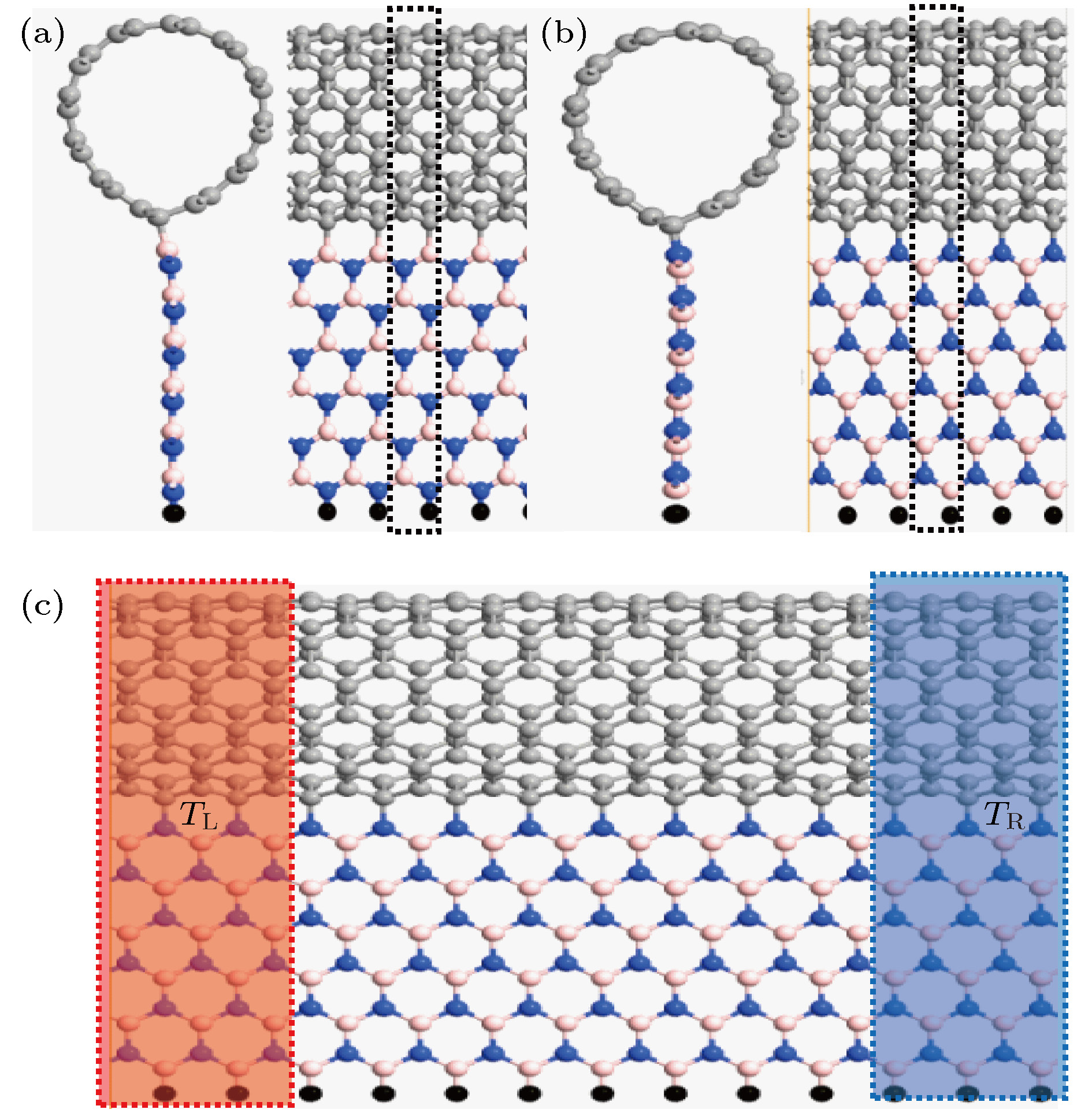
 下载:
下载:
